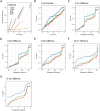Identification of the mode of evolution in incomplete carbonate successions
- PMID: 39180003
- PMCID: PMC11342597
- DOI: 10.1186/s12862-024-02287-2
Identification of the mode of evolution in incomplete carbonate successions
Abstract
Background: The fossil record provides the unique opportunity to observe evolution over millions of years, but is known to be incomplete. While incompleteness varies spatially and is hard to estimate for empirical sections, computer simulations of geological processes can be used to examine the effects of the incompleteness in silico. We combine simulations of different modes of evolution (stasis, (un)biased random walks) with deposition of carbonate platforms strata to examine how well the mode of evolution can be recovered from fossil time series, and how test results vary between different positions in the carbonate platform and multiple stratigraphic architectures generated by different sea level curves.
Results: Stratigraphic architecture and position along an onshore-offshore gradient has only a small influence on the mode of evolution recovered by statistical tests. For simulations of random walks, support for the correct mode decreases with time series length. Visual examination of trait evolution in lineages shows that rather than stratigraphic incompleteness, maximum hiatus duration determines how much fossil time series differ from the original evolutionary process. Gradual directional evolution is more susceptible to stratigraphic effects, turning it into punctuated evolution. In contrast, stasis remains unaffected.
Conclusions: • Fossil time series favor the recognition of both stasis and complex, punctuated modes of evolution. • Not stratigraphic incompleteness, but the presence of rare, prolonged gaps has the largest effect on trait evolution. This suggests that incomplete sections with regular hiatus frequency and durations can potentially preserve evolutionary history without major biases. Understanding external controls on stratigraphic architectures such as sea level fluctuations is crucial for distinguishing between stratigraphic effects and genuine evolutionary process.
Keywords: Carbonate platform; Fossil record; Mode of evolution; Paleobiology; Paleontology; Stratigraphy; Time series; Trait evolution.
© 2024. The Author(s).
Conflict of interest statement
The authors declare no competing interests.
Figures










Similar articles
-
Biased, Spasmodic, and Ridiculously Incomplete: Sequence Stratigraphy and the Emergence of a New Approach to Stratigraphic Complexity in Paleobiology, 1973-1995.J Hist Biol. 2023 Oct;56(3):419-454. doi: 10.1007/s10739-023-09720-0. Epub 2023 Aug 3. J Hist Biol. 2023. PMID: 37535224
-
The relative importance of directional change, random walks, and stasis in the evolution of fossil lineages.Proc Natl Acad Sci U S A. 2007 Nov 20;104(47):18404-8. doi: 10.1073/pnas.0704088104. Epub 2007 Nov 14. Proc Natl Acad Sci U S A. 2007. PMID: 18003931 Free PMC article.
-
Fossil preservation and the stratigraphic ranges of taxa.Paleobiology. 1996 Spring;22(2):121-40. doi: 10.1017/s0094837300016134. Paleobiology. 1996. PMID: 11539203
-
The fossil record and estimating divergence times between lineages: maximum divergence times and the importance of reliable phylogenies.J Mol Evol. 1990 May;30(5):400-8. doi: 10.1007/BF02101112. J Mol Evol. 1990. PMID: 2111853 Review.
-
Morphological homeostasis in the fossil record.Semin Cell Dev Biol. 2019 Apr;88:91-104. doi: 10.1016/j.semcdb.2018.05.016. Epub 2018 May 30. Semin Cell Dev Biol. 2019. PMID: 29787861 Review.
References
-
- Albright R, Langdon C, Anthony KRN. Dynamics of Seawater Carbonate Chemistry, Production, and calcification of a coral reef flat, Central Great Barrier Reef. Biogeosciences. 2013;10(10):6747–58. 10.5194/bg-10-6747-2013.10.5194/bg-10-6747-2013 - DOI
-
- Anders MH, Scot W, Krueger, Sadler PM. A New look at Sedimentation Rates and the completeness of the Stratigraphic Record. J Geol. 1987;95(1):1–14. 10.1086/629103.10.1086/629103 - DOI
-
- Balthasar U, and Maggie Cusack. Aragonite-Calcite seas—quantifying the Gray Area. Geology. 2015;43(2):99–102. 10.1130/G36293.1.10.1130/G36293.1 - DOI
-
- Barido-Sottani Joëlle, Pohle A, Baets KD, Murdock D, Rachel CM, Warnock. Putting the F into FBD Analysis: Tree constraints or Morphological Data? Palaeontology. 2023;66(6):e12679. 10.1111/pala.12679.10.1111/pala.12679 - DOI
MeSH terms
Substances
Grants and funding
LinkOut - more resources
Full Text Sources
